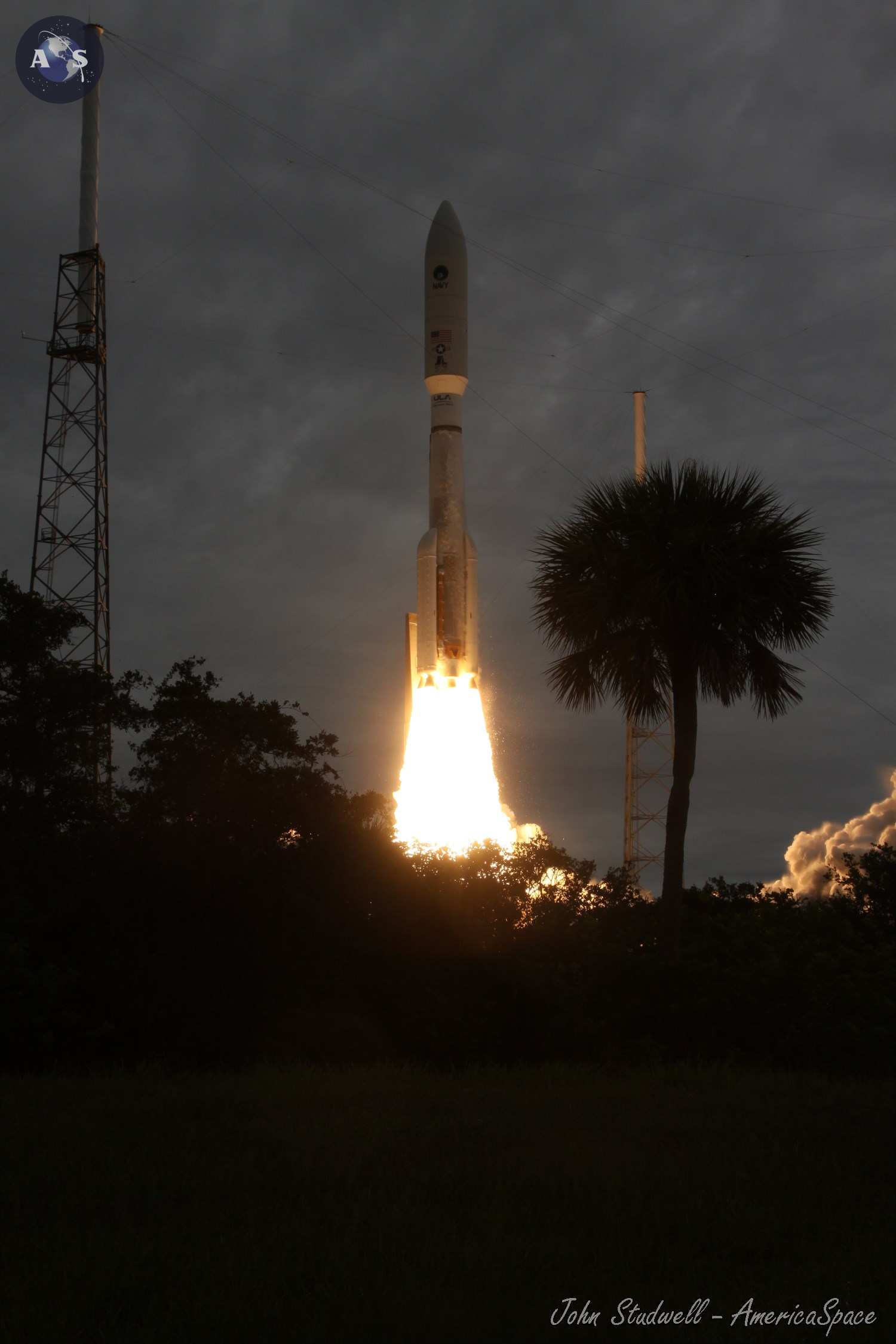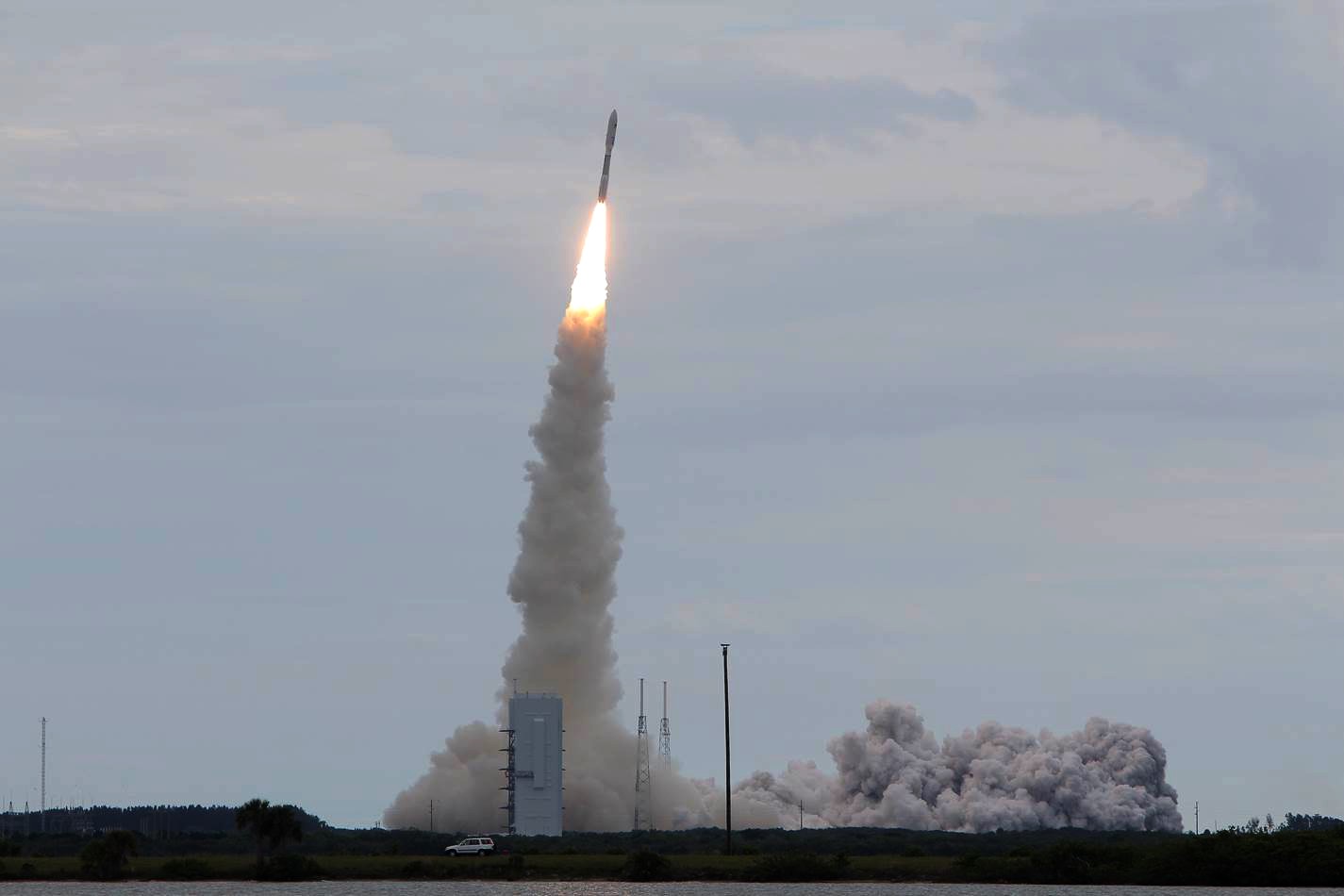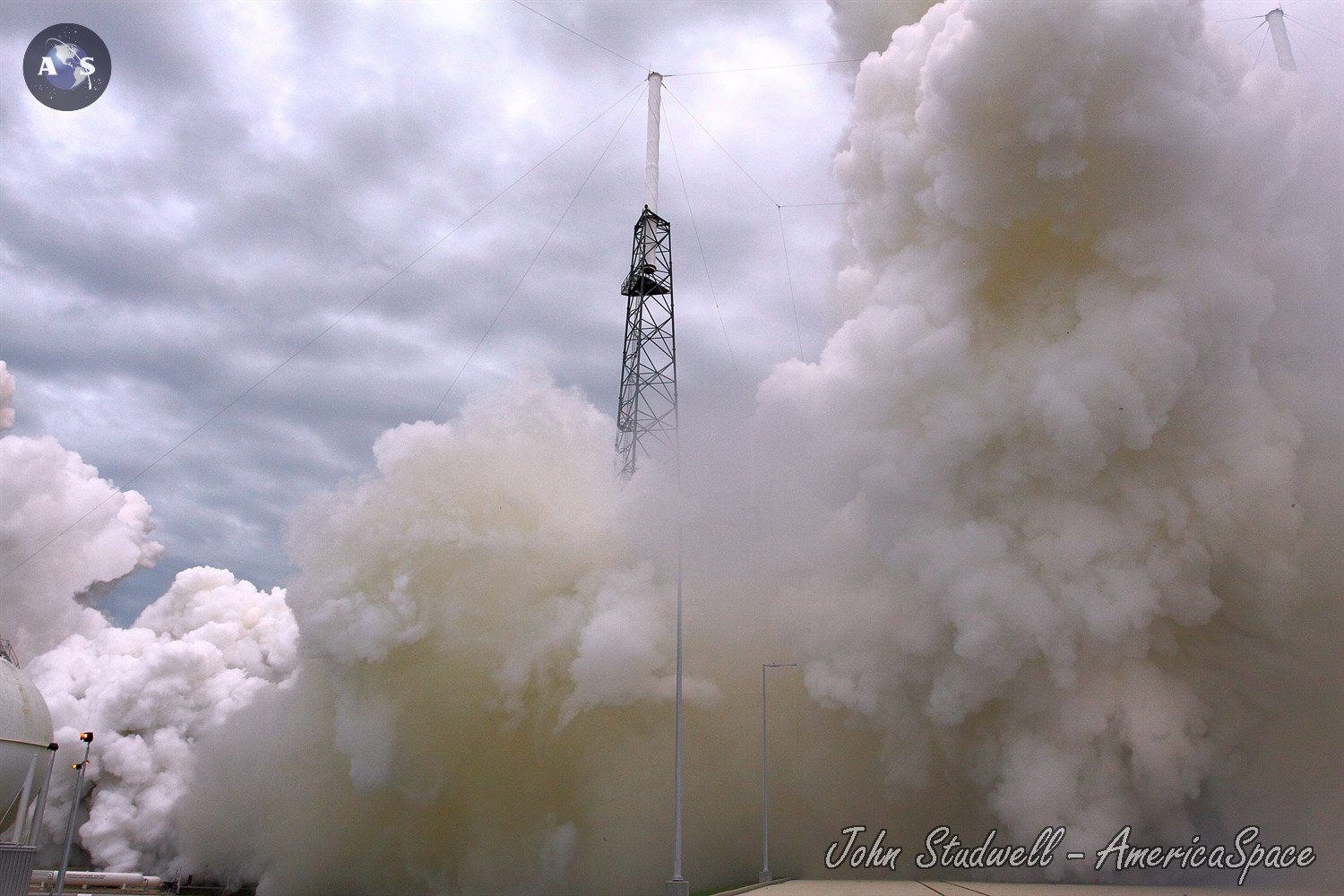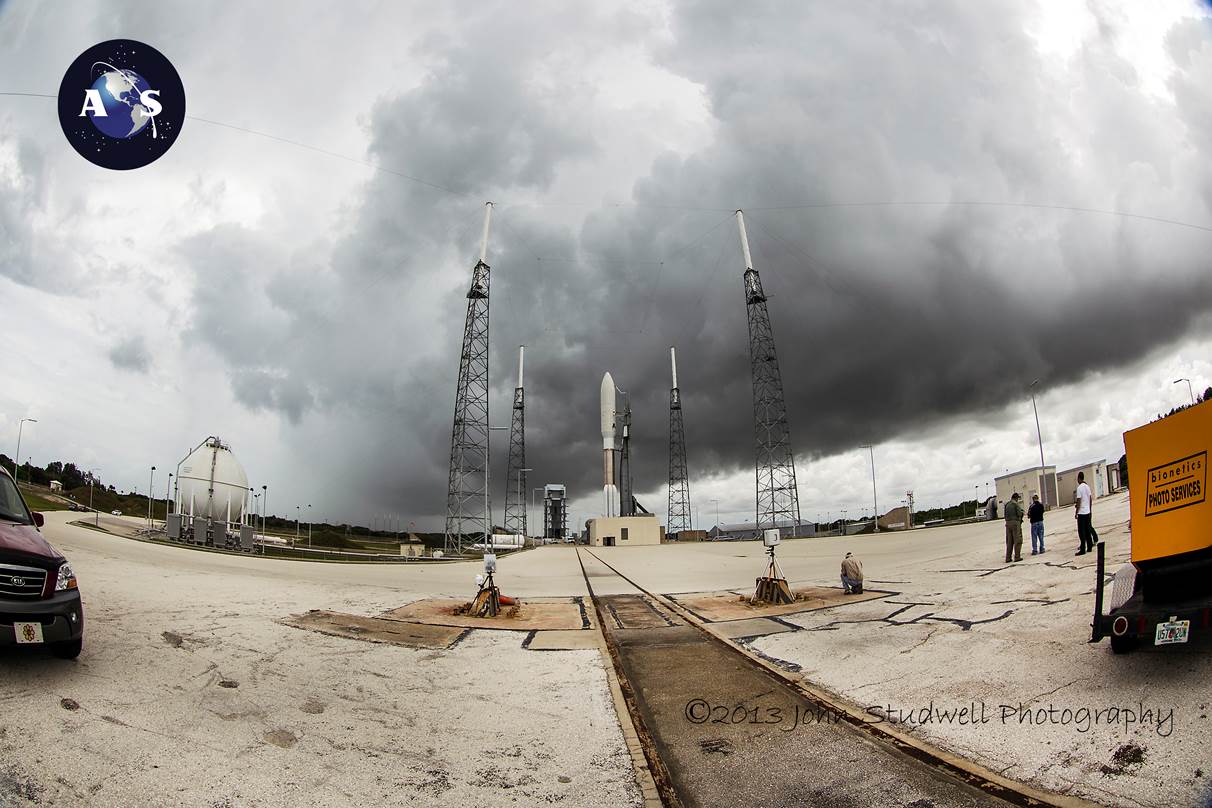
CAPE CANAVERAL, Fla — Today United Launch Alliance (ULA) successfully sent the U.S. Navy’s Mobile User Objective System 2 (MUOS-2) satellite into geosynchronous orbit at 9:00 a.m. EDT from Cape Canaveral Air Force Station’s Space Launch Complex 41 (SLC-41) in Florida. Liftoff occurred despite predictions of less than favorable weather conditions, but not at the opening of the launch window, which took place at 8:48 a.m. EDT. Forecasts had only provided an 40 percent chance of favorable conditions for launch, this improved to 80 percent by launch time. ULA employed the venerable Atlas V rocket in its 551 configuration to deliver the large MUOS-2 satellite to orbit. Controllers had a total of 44 minutes in the window in which to get the rocket off the pad.
High upper level winds were the culprit behind the slight delay of today’s launch.

The 551 version of the Atlas launch vehicle features a 5.4-meter (17.7-foot) payload fairing, a single RD-180 engine in the first stage (which is aided in its task by five strap-on solid-fueled rockets), and a single-engine Centaur upper stage. The solid rocket motors are produced by Aerojet Rocketdyne. This launch marked a first step for the newly-merged Aerojet Rocketdyne (Aerojet Rocketdyne was formed this year with the merger of Aerojet and Pratt & Whitney Rocketdyne).
“Aerojet Rocketdyne propulsion systems played a major role in successfully placing the second of five Mobile User Object System satellites into orbit for the U.S. Navy,” said Aerojet Rocketdyne’s President Warren M. Boley, Jr. “Along with being an important launch for the country, MUOS-2 represents our first integrated mission encompassing key products from both our heritage companies.”

At T-2.7 seconds, the Atlas’ Russian-built RD-180 first stage engine roared to life. The five solids then ignited and the climb-out from SLC-41 was underway at T+1.1 seconds. At approximately 85 seconds, the Centaur upper stage commanded a pitch, roll and yaw maneuver in order to set the Atlas on its proper flight azimuth. During the vehicle’s ascent, the RD-180 throttled down and begin a zero pitch, zero yaw angle of attack to minimize aerodynamic loading. After passing through the phase of maximum aerodynamic pressure (max-q), at T+103 seconds, the five solids were jettisoned, having exhausted their fuel. After three minutes, the payload fairing was jettisoned. The RD-180 was jettisoned at T+202 seconds.
At that point, the Centaur and the MUOS-2 payload separated. The Centaur will perform three burns, the first burn of seven minutes and 47 seconds placing it into a low-parking orbit. The second burn of six minutes will place it into an intermediate transfer orbit, where the Centaur and payload will stay for 2.4 hours. After a 59 second burn, the spacecraft will be placed into a Spacecraft Separation Transfer Orbit. When it achieves this milestone, main engine cutoff (MECO) will take place. The spacecraft will then separate from its booster.

Stacking of the 206 foot tall Atlas 551 got underway at Cape Canaveral’s Vertical Integration Facility on May 29. The 106.6 foot long Common Booster Core (CBC), a central component of this launch configuration’s first stage, was rotated into its proper position on the launch platform. The five Aerojet Rocketdyne solid rocket motors were then mounted to the launch vehicle. The 41.5 foot tall Centaur upper stage, elemental in propelling the payload into its desired orbit, was hoisted into position on June 11. On July 8, the MUOS-2 satellite, inside of its fairing, was placed on top of the launch vehicle. The Atlas V has flown 38 times successfully since 2002.
The Navy’s MUOS-2 joined its sister satellite, MUOS-1, in orbit; the latter satellite was launched in 2012. MUOS represents part of the next generation of narrowband tactical satellites, offering U.S. military forces improved communications capability while on the move. The MUOS system seeks to offer global satellite communications narrowband (64 kbits/sec and lower) connectivity to U.S. and allied forces. The system is intended to eventually replace the UHF Follow-On (UFO) network before that system reaches the end of its operational life.
When fully functional, the MUOS system will enrich communications for forces at sea, in ground vehicles, on the ground and in the air by enhancing mobility, access, capacity and quality of service. It will allow for information – via voice, video and data – to be disseminated well beyond physical sight, enhancing military operations. The system will make this possible by operating in UHF frequencies (which are lower than conventional cellular networks), allowing communications to be made possible in remote areas, such as dense forests.
The initial contract between Lockheed Martin and the U.S. Navy’s Communications Satellite Program Office for this project was announced in September 2004. It was extended for seven years and valued at $2.1 billion for the two initial satellites. The contract and program has been extended. MUOS-3 and MUOS-4 are expected to launch in 2014, while MUOS-5 is intended to leave Earth in 2016. All satellites will be propelled to orbit using the Atlas launch vehicle.
As reported previously on AmericaSpace, original plans called for the first MUOS satellite to be launched by 2010, but budgetary adjustments made in response to the Iraq War led to a two-year delay. Today’s launch represents only the fourth occasion in the Atlas V’s 11-year history to utilize the 551 configuration: MUOS-1 used it, as did NASA’s New Horizons spacecraft, bound for Pluto, which was launched in January 2006, and the Juno orbiter, dispatched toward Jupiter in August 2011.
“At nearly 15,000 pounds, MUOS-2 is the heaviest satellite launched to date by an Atlas launch vehicle, and today’s Atlas vehicle provided 2.5 million pounds of thrust during the boost phase,” Jim Sponnick, ULA vice president, Atlas and Delta Programs.
Today’s launch was ULA’s 6th of a total of 12 missions scheduled for the year. It is the 72nd launch since the company was formed in 2006 from elements originating from Lockheed-Martin and The Boeing Company.
With a current launch date of August 7 – ULA has less than three weeks before it will conduct its next launch, a Delta IV Medium with its Wideband Global Satellite 6 payload from Cape Canaveral’s Space Launch Complex 37. Liftoff for this mission is set to occur at 8:29 p.m. EDT.
Want to keep up-to-date with all things space? Be sure to “Like” AmericaSpace on Facebook and follow us on Twitter: @AmericaSpace
Missions » MUOS » Missions » MUOS » MUOS-2 »




2 Comments
2 Pings & Trackbacks
Pingback:United Launch Alliance Accomplishing Milestones at Rapid Pace « AmericaSpace
Pingback:Flashbacks to Apollo: Navy’s USS Arlington Recovers Orion Crew Module During Test « AmericaSpace